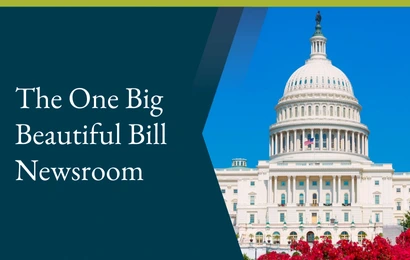The One Big Beautiful Bill Act’s Impact on Real Estate
By Reuben Rutman, Stephen Lee, and Loretta WangThe One Big Beautiful Bill Act (OBBBA) (Pub. L. No. 119-21), is the largest overhaul of federal tax laws since the 2017 Tax Cuts and Jobs Act (TCJA) and presents unique opportunities and challenges for the real estate industry. While the OBBBA extends or makes permanent many of the flagship provisions of the TCJA already in effect, it also includes new and significant changes to the federal tax code. Although many provisions are not effective until 2026, real estate owners, operators and investors may see the effects of the OBBBA as early as tax year 2025. Proper tax planning can help businesses and individuals better understand the impact of the OBBBA and maximize potential tax benefits. Since the OBBBA was signed into law on July 4, 2025, Citrin Cooperman’s Real Estate Industry Practice has been busy discussing with clients the provisions of the bill which are most applicable to the real estate industry and ensuring that these provisions are being considered in short- and longer-term planning. These provisions are discussed below.
Additional First-Year Depreciation Allowance for Certain Business Property
Under TCJA, qualifying property was eligible for 100% bonus depreciation if acquired after September 27, 2017, and placed in service before January 1, 2023. Thereafter, the amount would be phased down by 20% per year. The OBBBA permanently reinstates the 100% bonus depreciation allowance for qualifying property acquired and placed into service after January 19, 2025, without a phase-down.
Tangible property may be considered “qualifying property” if it is depreciable over a recovery period of 20-years or less, and thus includes property such as depreciable land improvements, furniture, fixtures, equipment, private planes and passenger automobiles. Qualifying property also includes Qualified Improvement Property (QIP), a category also originally established under the TCJA, which is defined as any improvement to an interior portion of a nonresidential building after the building is placed in service, but does not include building enlargements, elevators or escalators, or the internal structural framework of the building.
The reinstatement of 100% bonus depreciation can be a valuable planning opportunity for businesses that are constructing or purchasing new property or improving existing property. Particularly when paired with a cost segregation study, which can help identify bonus eligible components in what would otherwise be property depreciable over 27.5 or 39 years, businesses may be able to achieve significant tax savings through accelerated depreciation deductions.
While bonus depreciation can be claimed on certain “listed property” such as private airplanes and passenger automobiles, it must be predominantly used for business purposes (i.e., more than 50 %) in the year it is placed in service and each year thereafter or it will be subject to subsequent recapture. For example, if the qualified business use of the listed property decreases to 50% or below in a year following the year it was placed in service, the taxpayer will not lose the bonus depreciation that was previously deducted. However, the taxpayer is required to recalculate depreciation using the straight-line ADS method from the date placed in service through the year that the business use percentage drops to 50% or below. This recalculated depreciation is then compared to the depreciation previously claimed (including bonus depreciation), and the excess is subject to recapture as ordinary income in the year the property falls below the required threshold. Due to the importance of meeting the business use requirement, businesses planning to purchase listed property should consider working with a tax advisor to ensure their intended use will qualify.
Expensing of Certain Business Assets
Under Section 179, businesses may elect to expense eligible property in the year it is placed in service. However, Section 179 expensing is subject to a maximum dollar limitation. Previously, the maximum Section 179 expense allowable for tax year 2025 was $1.25 million, reduced dollar-for-dollar by the amount by which the total cost of qualifying property placed in service during the year exceeds the phase-out threshold of $3.13 million. OBBBA increased Sec. 179 expensing to allow $2.5 million of immediate deductions. This deduction starts to phase out when qualifying purchases exceed $4 million in 2025 with a full phaseout at $6.5 million, for property placed in service in 2025. These thresholds will be indexed for inflation beginning in 2026. Section 179 expensing is subject to taxable income limitations that do not apply to bonus depreciation.
Section 179 eligible property includes certain tangible depreciable personal property and off-the-shelf computer software used in a trade or business, as well as qualified real property including qualified improvement property (QIP) and certain improvements made to roofs, HVAC property, fire protection and alarm systems, and security systems.
Due to the reinstatement of 100% bonus depreciation by the OBBBA, the utility of Section 179 is reduced for property that qualifies for both provisions, such as QIP. However, tangible property that falls outside of bonus eligibility, such as roofs, may still qualify for immediate expensing under Section 179. With proper planning, businesses can maximize their tax benefits under these two provisions in years of significant capital spending.
Business Interest Expense Limitation
Section 163(j) generally limits business interest expense deducted to the total of (1) business interest income, (2) 30% of adjusted taxable income (ATI), and (3) floor plan financing interest. For tax years 2018 through 2021, ATI was computed similarly to EBITDA, earnings before interest, taxes, depreciation and amortization. However, for tax years 2022 and onward, depreciation, amortization and depletion are no longer allowed to be added-back for ATI purposes, essentially switching to a more restrictive EBIT computation. As real estate businesses often incur a significant amount of interest expense, application of the post-2021 ATI rules frequently resulted in new or increased disallowances of business interest deductions.
To address this, many real estate businesses make the real property trade or business election (RPTOB election) that effectively turns off the Section 163(j) interest expense limitation. In exchange, the electing business is required to depreciate certain real property over a longer recovery period and is ineligible to take bonus depreciation on QIP.
For tax years beginning after December 31, 2024, the OBBBA permanently adjusts the ATI calculation to once again be before deductions allowable for depreciation, amortization, and depletion — a return to the pre-2022 EBIDTA computation. In addition, for tax years beginning after December 31, 2025, the Section 163(j) limitation is to be computed before the application of interest capitalization rules (with some exceptions), potentially subjecting additional business interest to limitation, and further adjusts the ATI calculation to exclude certain foreign income inclusions. Of note for real estate businesses, interest capitalized under Section 263A(f), which applies to certain real or tangible personal property produced, is excluded from the definition of business interest expense under the revised rules.
Real estate businesses that were previously considering making RPTOB elections in tax year 2025 should consider whether the election is still beneficial after application of the new ATI calculation rules under the OBBBA. As the revised ATI calculation may result in lower or no business interest expense disallowance, the RPTOB election may be unnecessary or result in fewer cost savings compared to taking 100% bonus depreciation on QIP.
Deduction for Qualified Business Income
Section 199A generally allows individuals, estates and trusts to claim a deduction of up to 20% of their qualified business income (QBI) from certain non-corporate trades or businesses, as well as up to a 20% deduction for qualified REIT dividends and qualified publicly traded partnership income. The provision, which was set to expire on December 31, 2025, is now permanent under the OBBBA.
For individuals, estates and trusts with taxable income more than certain threshold amounts, the QBI deduction may be subject to additional phase-in limitations based on the W-2 wages or capital investment of the qualified business. The OBBBA increases the phase-in limitation from $50,000 to $75,000 for non-joint filers, and from $100,000 to $150,000 for joint filers, for tax years beginning after December 31, 2025.
As many real estate businesses are conducted in pass-through form, the permanent extension of Section 199A and increased phase-in limitations are welcomed changes to the pre-OBBBA tax laws. For investors in REIT structures in higher income tax brackets, the extension of Section 199A also creates ongoing tax benefits because REIT dividends are eligible for the 20% QBI deduction without any phase-in limitations based on the W-2 wages and capital investment of the underlying business.
Qualified Opportunity Zones (QOZ)
The QOZ program has been extended indefinitely under the OBBBA. The original QOZ program was scheduled to expire for new investments on December 31, 2026. Under the new QOZ program, each state will create new zones by July 1, 2026, which will be effective on January 1, 2027. The new QOZ program will apply only to eligible gains invested after December 31, 2026, and will be granted a five-year deferral and a 10% basis step-up. There is a 30% step up after five years for investors in qualified rural opportunity funds (QROFs). QROFs will be designated rural areas with a population of less than 50,000 people. The OBBBA does not change the taxability of gains deferred under the TCJA’s QOZ program. Therefore, eligible gains invested on or before December 31, 2026, are deferred only to December 31, 2026.
OZ investors should evaluate how deferred gains will affect their 2026 tax liability as the original deferrals come due. In most cases, the amount recognized will equal the gain originally deferred. However, if an investment’s fair market value is lower at the time of recognition, the statute measures the inclusion amount by reference to that fair market value, which could result in a lesser recognized gain. The statute and regulations do not specify how fair market value is determined or by whom. While Qualified Opportunity Funds must report the value of their underlying assets for compliance purposes, that information is not necessarily the same as the fair market value of an individual investor’s interest. As 2026 approaches, investors should coordinate with both their fund and their tax advisors to ensure valuation positions are supportable and applied consistently.
To defer capital gains under the new QOZ program, taxpayers will need to structure property sales in a manner that allows for eligible gain investments in 2027 or later.
For example, calendar year pass-through entities may recognize a gain on the sale of a capital asset as early as January 1, 2026, and the owners of the passthrough entity may elect to have their proportionate gain deferred under the new QOZ program. This is because their 180-day investment window could start on either the last day of the pass-through entity’s taxable year (December 31, 2026), or the original due date of the pass-through entity’s 2026 tax return (i.e., March 15, 2027), which stretches the 180-day window as far out as September 15, 2027. This flexibility allows pass-through owners to choose a starting point that aligns best with their investment strategy and timing of capital deployment.
It should be noted that passthrough entity owners would also have the option of starting their 180-day investment window from January 1, 2026, the date of sale from our example above, but this would result in the gain only being deferred until December 31, 2026, under the old QOZ program.
Qualified Production Property
The OBBBA adds a new type of property, qualified production property (QPP), and provides 100% first year depreciation for such property. QPP includes certain nonresidential real property, but only the portions used directly and integrally by the taxpayer in a qualified production activity (QPA). The construction of QPP must begin after January 19, 2025, and before January 1, 2029, and placed in service before January 1, 2031. Nonresidential real property acquired by purchase (rather than newly constructed by the taxpayer) after January 19, 2025, and before January 1, 2029, may also qualify as QPP if, among other things, the property was not previously used by the taxpayer (or certain related persons), or used in a qualified production activity by any person between January 1, 2021, and May 12, 2025. If a taxpayer enters into a written binding contract to acquire the property, the date of contract governs when determining whether the taxpayer meets the acquisition date requirement.
Qualified production activity (QPA) is the manufacturing, production, or refining of a qualified product. QPA must result in a substantial transformation of the property comprising the product. QPP does not include any portion of nonresidential real property used for functions unrelated to the manufacturing, production, or refining of tangible personal property. Excluded property includes, for example, property used for offices. Taxpayers should be careful in maintaining the production property as QPP for ten years after it is placed in service, or they will have to recognize the previously taken 100% bonus depreciation as ordinary income.
Expiring Energy Efficiency Incentives
The Section 179D Energy Efficient Commercial Buildings deduction allowing qualifying taxpayers to claim a deduction of up to $5.81 per square foot will sunset for property beginning construction after June 30, 2026. In addition, the Section 45L New Energy Efficient Home Credit providing a tax credit to builders of single-family and multi-family homes of up to $5,000 will sunset for homes acquired after June 30, 2026. Taxpayers hoping to avail themselves of these incentives should be mindful of these June 30, 2026, deadlines.
Exception to Percentage of Completion Method
The OBBBA expands the exception from the percentage-of-completion (PCM) method for long-term construction contracts. Under prior law, only “home construction contracts” were fully exempt from the PCM. These contracts were narrowly defined to include construction of dwelling units in buildings containing four or fewer units, including certain associated site improvements. The amendment replaces the term “home construction contract” with the broader concept of “residential construction contract,” thereby extending the PCM exception to a wider range of residential building projects, including larger multi-family developments.
For these newly eligible contracts, the gross receipts threshold is also liberalized. While prior law required taxpayers to meet the Section 448(c) gross receipts test based on a two-year lookback, the revised rule permits a three-year lookback for residential construction contracts that do not qualify as home construction contracts.
This provision applies to long-term contracts entered in taxable years beginning after July 4, 2025, and may defer revenue recognition until the project is completed.
Other Key Provisions for Real Estate Investors
The OBBBA contains other key provisions that may be of interest to certain real estate investors. Below are some examples:
- Excess Business Losses of Noncorporate Taxpayers (IRC Section 461(l)): Under Section 461(l), individuals, estates and trusts may utilize cumulative business losses in excess of their cumulative business income to offset nonbusiness income up to certain inflation-adjusted threshold amounts. This provision, which was set to expire for tax years beginning after December 31, 2025, has been extended and continues to allow excess business losses to be treated as NOL carryforwards. This can be beneficial to taxpayers because NOLs can offset non-business income.
- State and Local Tax (SALT) Itemized Deduction for Individuals: The OBBBA temporarily increases the current $10,000 limitation on SALT itemized deductions for tax years 2025 through 2029 to $40,000 (for joint filers), while also introducing a phaseout for taxpayers with modified adjusted gross incomes above certain thresholds. As the increase to the SALT limitation is only temporary, workarounds such as state Pass-Through Entity Tax (PTET) regimes still offer valuable planning opportunities for real estate owners and investors.
- Increased Estate and Gift Tax Exemption: The OBBBA permanently raises the federal estate, gift, and generation-skipping transfer (GST) tax basic exclusion amount to $15,000,000 per individual, indexed annually for inflation. The new statutory baseline applies to taxable years beginning after December 31, 2025, and offers greater certainty for high-net-worth families engaging in long-term wealth transfer planning. The increased exemption creates opportunities to implement or increase lifetime gifting. In addition, trusts created under prior tax law may need to be revised to make sure they are set up to take advantage of these changes.
- Charitable Deduction Limitation: The OBBBA includes a new added reduction to deductible charitable contributions. They must be reduced by 0.5% of a taxpayer’s contribution base. The contribution base is adjusted gross income (AGI) determined without regard to any net operating loss carryback to the taxable year. For example, if the contribution base is $1,000,000, then .5% x $1,000,000 = $5,000 is not deductible.
How We Can Help / Contact Information
The OBBBA has made impactful changes to the real estate industry for owners, developers, and investors. Now is the time to determine how these changes could affect your particular circumstances. Our Real Estate Industry Practice is comprised of dedicated professionals with expertise that can assist you in navigating these sometimes-complex changes in the tax law. Whether it is planning or modeling, please feel free to contact a Citrin Cooperman professional to discuss your specific needs.
Explore the Latest OBBBA Updates

Latest Article Cards

Uncharted No More: Capital Sources in the Independent Sponsor Sector
Read More

Effective Retention Strategies for Advertising Agencies
Read More

Uncharted No More: Deal Sources in the Independent Sponsor Sector
Read More

Strategic Decisions for Successful Restaurants: Occupancy Costs
Read More



